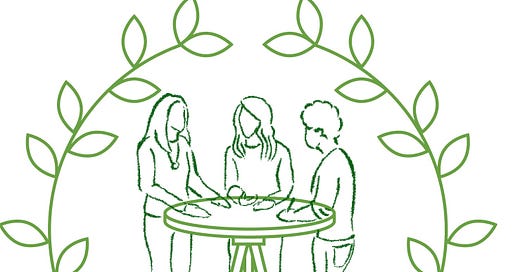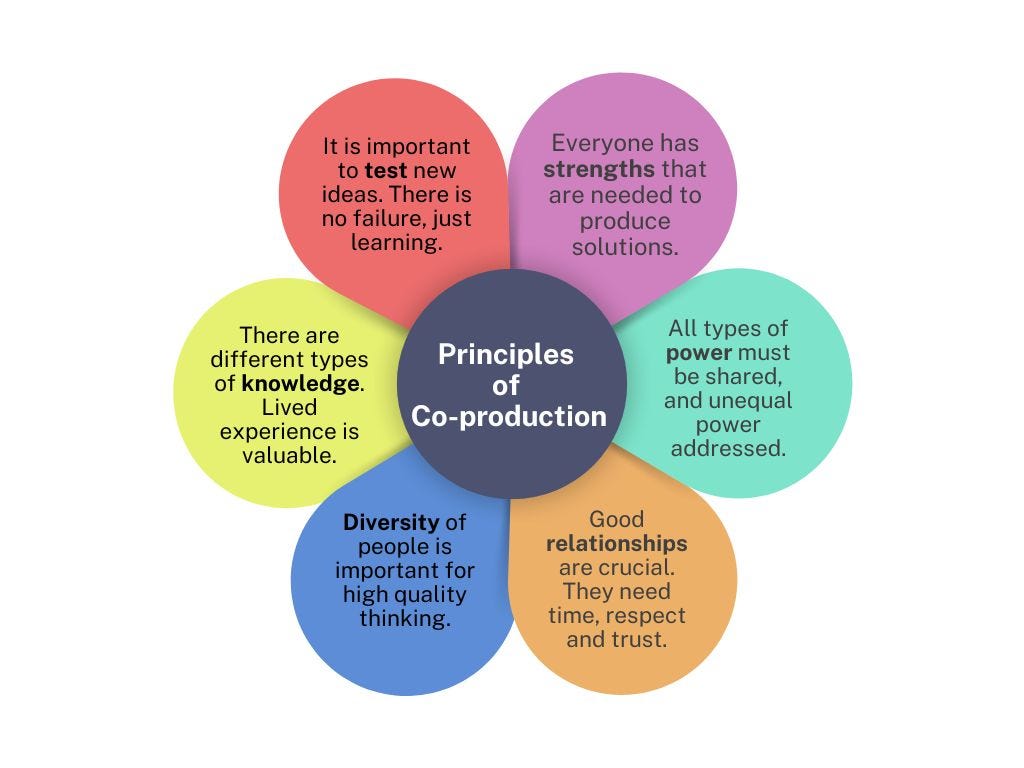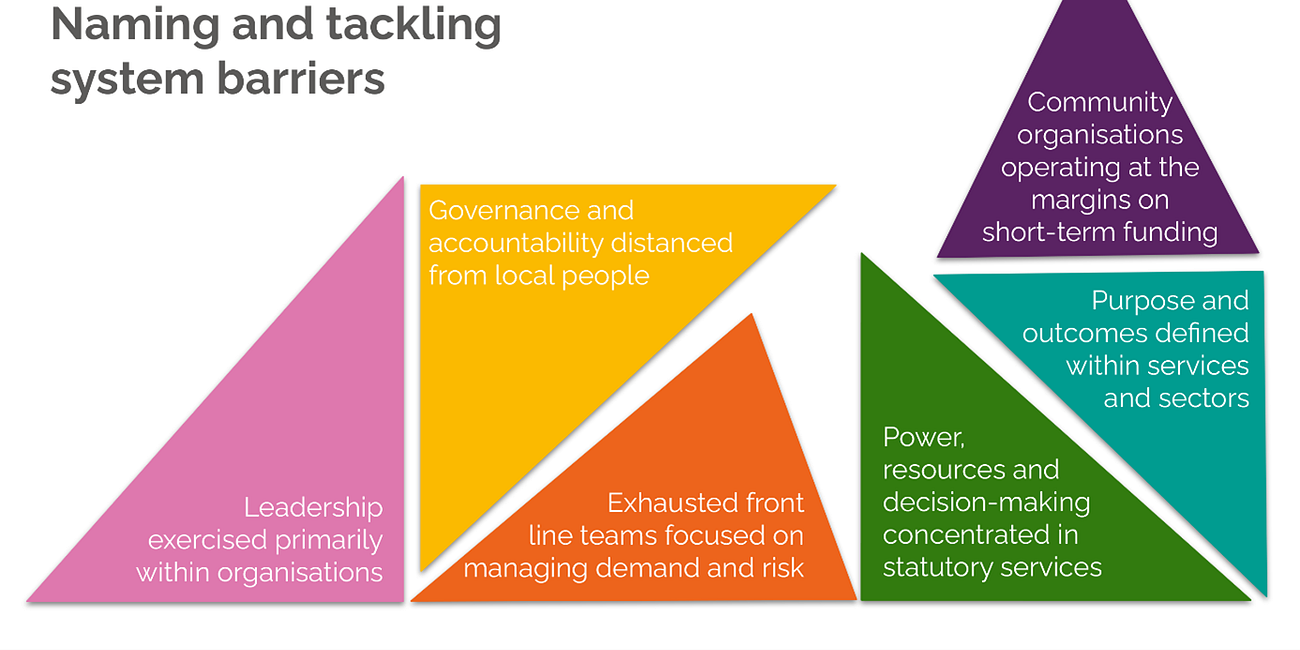What does co-production between local people and local anchor institutions look like in practice?
We are using co-production between local people and local anchor institutions to bridge the gap between economic development and public health in Salford. In chapter 4, we discussed how we prepared the ground for co-production with local people within Economies for Healthier Lives. Five months on feels like a good time to assess progress and to review the realities of co-production in practice.
Co-production with local people looks different each time that it is used, with different topics, groups and timescales, but there are six key principles that allow this approach to work really well. The Elephants Trail in Greater Manchester created a helpful infographic to reflect these principles and what they mean.
Genuine co-production with local people can take time to come together and often involves each group spending time preparing for the co-production stages. There can also be various elements of co-production to each piece of work with some more obvious than others.
Co-production in the beginning
Once the preparatory steps set out in chapter 4 were completed (equality impact assessment, recruitment of participants, payment set-up, venue choice, etc.), our co-production work started with Lewis (Project Co-production Facilitator) and a group of local people meeting together in a local venue for around 12 months. This time was spent nurturing relationships, self-development and understanding social and co-operative business. This intentionally took place without any external involvement or additional professionals, in order to allow the group to ‘own’ the environment and grow their own knowledge and agenda. We recommend choosing a venue where the local people live, are familiar with and can get to easily.
While this was taking place Orla (Project Manager) was working with the local anchor institutions in Salford in a parallel way: tending relationships and understanding of community wealth building and progressive procurement. This started with individual meetings with each of the local anchor institutions, moving towards the development of the Salford Local Anchors Network. The most significant progress was made with the local anchor institutions that involved a senior leader with decision-making power, as well as someone in an operational role. In this case, it was a knowledgeable procurement manager who would be the person or team making any changes. We recommend this process to ensure not only that all parties engaging in co-production enter with adequate understanding and feel prepared but also, most importantly, that power imbalances can be minimised.
As the project progressed, our role was facilitating the co-production between local people and local anchor institutions. This is both to create new local suppliers that keep more local the money spent by the anchors, and also for local people to have a strong economic option. Information sharing was a crucial element of this. The local anchor institutions shared supply chain data (spend categories, spend amounts, contract dates) with the local people, so they could assess the viability of business opportunities. This is not a common practice and took place after several months of nurturing relationships and trust in what we were trying to achieve. Similarly, the local people shared information about themselves, their ambitions and commitment to developing a trustworthy and quality social/co-operative business.
The beauty of this stage was the room for flexibility, ideas sharing and the equal need to grow knowledge, trust and a shared ambition for improving Salford and addressing inequalities. If you are facilitating co-production between groups, it is helpful to share, check and confirm mutual understanding of your aims and the role of everyone involved throughout. It is also useful to refer to the key principles of co-production, particularly the critical element of sharing power and addressing unequal power. Co-production can feel uncomfortable and difficult at times, especially if this is a new approach to those involved. Sharing power and decision-making is not done often and so can feel unfamiliar. Discomfort can be a positive sign that it is working.
Bringing the local people and local anchor institutions together
Once the business areas had been provisionally decided (pest control and food and catering), it was time to make the collaboration a reality. The market analysis process discussed in chapter 7 details how the group of local people came to choose these areas for their social enterprises. This was a process which assessed viability of each category, strengths and interests of the group. The emerging social/co-operative business owners spent time creating plans and ideas around what each of the social/co-operative businesses would offer and require, all based on opportunities with some of the local anchor institutions in Salford.
Before long, it was time for the local people to meet with the local anchor institutions that offered tangible and realistic market opportunities and were willing to give the new social/co-operative businesses a chance as potential new suppliers. The purpose of these meetings was to explore business plans, the potential opportunities and possible terms that would work for both parties. The mutuality is crucial to the success of this work.
To prepare for the parties to meet and share, we recommend thinking about the purpose of the meeting, who should attend, the venue, and the desired outcomes for each group.
An indicator for us that the co-production process was going well was the successful meeting between a procurement manager and the emerging social/co-operative business owners. Due to the preparations with both parties, they were able to comfortably share their positions and plans. The local anchor institution offered ways to personalise the contracting process for the new social/co-operative business. These included shortened payment terms and a willingness to build on the contract offer to suit the capacity of the social/co-operative business.
Image by Eden Lew
During your own co-production with local people, think about what success would look like at each stage and document any indicators along the way that can suggest whether or not a resolution is getting closer. The indicators might include a change in language or presentation by either or both parties, greater flexibility, new ideas and a shift in thinking.
What are we doing now?
As pleased as we are about the journey so far, it has not been without its stumbling blocks. The road to co-producing an approach to addressing health inequalities using economic development has shifted and adapted many times. There were many emails, calls and meetings back and forth to explain, discuss, share and pivot plans. We faced challenges of reduced contract opportunities, staff changes, local people moving on and life changes that affected time and resource commitment to the project.
However, we also came upon many hopeful prospects and opportunities that presented just when we needed them! Our partnerships and connections built across the past two years have resulted in doors opening when others closed. The diversity in the groups of local people has allowed creativity to fill gaps in opportunity.
We are still exploring different avenues to allow the groups of local people to set up the two social/co-operative businesses and the local anchor institutions to pave the way in progressive procurement at a grassroots level. Challenges such as time, resources and finances are areas we are currently focused on. Creating an infrastructure to growing the social economy locally and regionally is highlighting gaps or spaces that we need to explore in order to ensure we can address inequalities and enable economic development to have a positive impact on the health and well-being of everyone. The links between health and social business have been documented well by The Yunus Centre for over 10 years and using this evidence base is an important element of obtaining the buy-in needed to begin with system change. We will be covering this more in the next chapter so please subscribe now to receive this straight to your inbox.
We recommend linking to planning and regeneration teams locally to learn about upcoming plans. New and unexpected opportunities might arise. Asset mapping can also be a useful tool to keep engaged with your local area and understand the strengths and resources that already exist.
If you are working on something similar in progressive procurement or growing social/co-operative business in your area, we would love to hear about your experiences doing this.
If you’re enjoying this series, or have any feedback for us on how we can share more please get in touch by commenting below or sending an email to ehlsalford@unlimitedpotential.org.uk.
Next time:
How can you get buy-in from system leaders to change the conditions?
Next chapter here:






